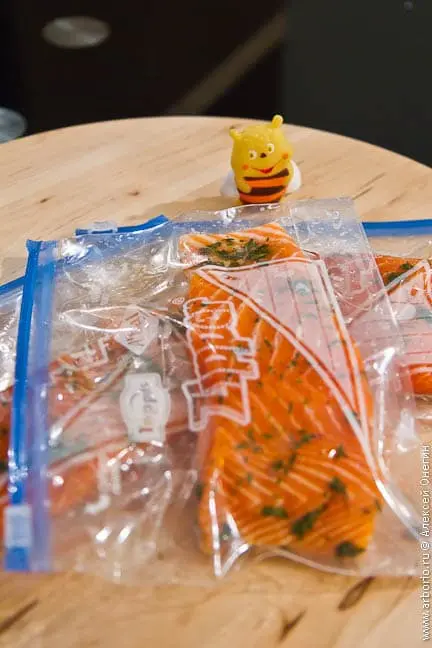Many of you, dear friends, have already read what I wrote about the suvid technology, and some, as far as I know, successfully apply it at home. This means that I will not have to talk for a long time about the main drawback of this technology, which at the same time prevents its appearance in the kitchens of not only people who are keen on food, but also ordinary housewives: a relatively high “entry price”, that is, the amount that you will have to pay to cook your first chicken breast or salmon fillet in a suvid.
There is nothing to be surprised at: some kind of meat grinder or blender, which are always in business, is one thing, but if we are talking about devices of not quite clear purpose, few will rush to shell out for them.

To try out a new technology, however, additional costs are not necessary – for example, you can vacuum packing products (well, almost) without a vacuum sealer. This method can be called air displacement by waterand once you master it, you will realize that it has many uses. These include:
- Souvide cooking… This method not only can completely replace the vacuum apparatus, but in some cases (for example, if you need to pack a liquid in a bag – oil, broth, marinade, etc. – or products that are extremely sensitive to squeezing) is more preferable.
- Storage… Of course, “real” vacuum is preferable, but by packing the product in a bag using the water displacement method, you can expect that it will last significantly longer in the refrigerator.
- Freezing… One of the enemies of frozen food is weathering, but packing in a bag from which air has been removed can significantly slow down this process, extending the shelf life of food in the freezer.
This method has other uses, but the ones I described above are enough to interest those who have not heard of it. Therefore, without delay, I pass on to its description.
Water displacement method
To get started, you will need to buy plastic ziplock bags, which are usually sold in the foil, cling film and sandwich bag areas. A ziplock is a fastener that looks like a zipper and moves back and forth to open or close the bag. An example of such packages is shown in the photo below:

When choosing bags, make sure that they are food grade plastic, and be guided by the fact that their size exceeds the size of the products that you will pack: in order to remove as much air as possible, it is necessary that there is free space around the product – ideally at least 2 centimeters on the right, left and bottom, and at least 5 centimeters above.
The sequence of further actions is as follows:
1. Place the product (a piece of meat, fish, cheese, etc.) in a bag and close the ziplock almost completely, leaving the bag ajar only a couple of centimeters.
2. Fill a large saucepan or other container that will fit your bag easily with regular tap water.
3. Gently dip the bag into water, which will squeeze air out of it so that the bag sticks together. The package must be immersed in water almost completely, leaving only a slightly open part above its surface, from which air will escape.
4. When the whole bag, except for a small part of it, is under water, and you see that almost all the air has come out of it, close the bag and remove it from the water.
5. You have packaged your food in a virtually airless environment, and now you can cook it in a souvide or store it in the refrigerator or freezer. After using the bag, you can throw it away or, if you wish, wash and reuse it.
At the same time, it should be borne in mind that some ziplock bags can begin to leak air over time, so I do not recommend using them for long-term storage. I hope I have described everything more than intelligibly, but if you are one of those who are better off seeing once than hearing a hundred times – pay attention to the short and clear video:









